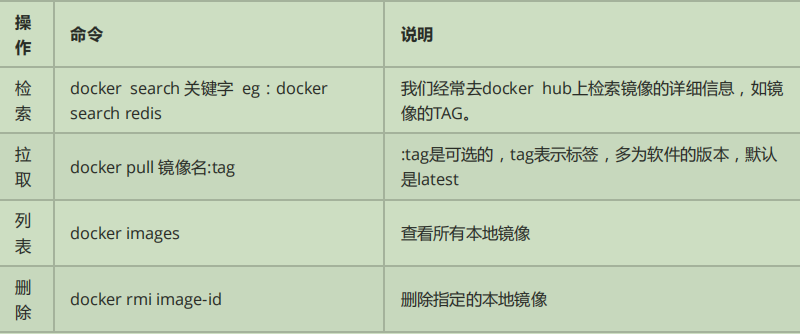Docker:

3、容器操作:
根据镜像启动容器:docker run ‐‐name mytomcat ‐d tomcat:latest
如果需要映射端口,则使用-p参数:docker run ‐d ‐p 8888:8080 tomcat
查看运行中的容器:docker ps
查看系统上所有的容器:docker ps ‐a
org.apache.tomcat.jdbc.pool.DataSource、HikariDataSource、BasicDataSource、
@ConditionalOnMissingBean(DataSource.class) @ConditionalOnProperty(name = "spring.datasource.type") static class Generic { @Bean public DataSource dataSource(DataSourceProperties properties) { //使用DataSourceBuilder创建数据源,利用反射创建响应type的数据源,并且绑定相关属性 return properties.initializeDataSourceBuilder().build(); } }
然后在配置文件配置spring.datasource.type属性即可;
4、DataSourceInitializer:ApplicationListener;
作用:
1)、runSchemaScripts();运行建表语句;
2)、runDataScripts();运行插入数据的sql语句;
可将sql文件放入项目中,然后通过配置文件指定就可在运行项目时自动建表;如:

导入druid类型的数据源:
编写配置类:
package com.example.demo.config; import javax.sql.DataSource; import org.springframework.boot.autoconfigure.condition.ConditionalOnClass; import org.springframework.boot.autoconfigure.condition.ConditionalOnProperty; import org.springframework.boot.web.servlet.FilterRegistrationBean; import org.springframework.boot.web.servlet.ServletRegistrationBean; import org.springframework.context.annotation.Bean; import org.springframework.context.annotation.Configuration; import com.alibaba.druid.spring.boot.autoconfigure.DruidDataSourceBuilder; import com.alibaba.druid.support.http.StatViewServlet; import com.alibaba.druid.support.http.WebStatFilter; @Configuration @ConditionalOnClass(com.alibaba.druid.pool.DruidDataSource.class) @ConditionalOnProperty(name = "spring.datasource.type", havingValue = "com.alibaba.druid.pool.DruidDataSource", matchIfMissing = true) public class DruidDataSource { public DataSource dataSourceOne() { return DruidDataSourceBuilder.create().build(); } @Bean public ServletRegistrationBean druidStatViewServlet(){ //org.springframework.boot.context.embedded.ServletRegistrationBean提供类的进行注册. ServletRegistrationBean servletRegistrationBean = new ServletRegistrationBean(new StatViewServlet(),"/druid/*"); //添加初始化参数:initParams //IP黑名单 (存在共同时,deny优先于allow) : 如果满足deny的话提示:Sorry, you are not permitted to view this page. servletRegistrationBean.addInitParameter("deny","192.168.1.73"); //登录查看信息的账号密码. servletRegistrationBean.addInitParameter("loginUsername","admin"); servletRegistrationBean.addInitParameter("loginPassword","123456"); //是否能够重置数据. servletRegistrationBean.addInitParameter("resetEnable","false"); return servletRegistrationBean; } @Bean public FilterRegistrationBean druidStatFilter(){ FilterRegistrationBean filterRegistrationBean = new FilterRegistrationBean(new WebStatFilter()); //添加过滤规则. filterRegistrationBean.addUrlPatterns("/*"); //添加不需要忽略的格式信息. filterRegistrationBean.addInitParameter("exclusions","*.js,*.gif,*.jpg,*.png,*.css,*.ico,/druid/*"); return filterRegistrationBean; } }
这里注入的ServletRegistrationBean、和FilterRegistrationBean都是druid特有的功能,可以实时监控数据库以及web的访问情况;需要注意的是得在配置中配好数据池的类型;
整合Mybatis:
注解版:
先在主进口类那里加上@MapperScan()注解,告诉容器应该扫描哪些mapper文件:

然后编写mapper类:
package com.example.demo.Mapper; import org.apache.ibatis.annotations.Delete; import org.apache.ibatis.annotations.Insert; import org.apache.ibatis.annotations.Mapper; import org.apache.ibatis.annotations.Select; import org.apache.ibatis.annotations.Update; import com.example.demo.bean.Department; @Mapper public interface DepartmentMapper { @Select("select * from department where id = #{id}") public Department getDeptById(Integer id); @Delete("delete from department where id = #(id)") public int deleteDeptById(Integer id); @Insert("insert into department(departmentName) values(#{departmentName})") public int insertDept(Department department); @Update("update department set departmentName = #{departmentName} where id = #{id}") public int updateDept(Department department); }
@Mapper指定这个操作数据库的mapper
通过controller调用mapper:
package com.example.demo.contoller; import org.apache.ibatis.annotations.Param; import org.springframework.beans.factory.annotation.Autowired; import org.springframework.web.bind.annotation.GetMapping; import org.springframework.web.bind.annotation.PathVariable; import org.springframework.web.bind.annotation.RestController; import com.example.demo.Mapper.DepartmentMapper; import com.example.demo.Mapper.EmployeeMapper; import com.example.demo.bean.Department; import com.example.demo.bean.Employee; @RestController public class DeptController { @Autowired DepartmentMapper departmentMapper; @Autowired EmployeeMapper employeeMapper; @GetMapping("/dept/{id}") public Department getDepartment(@PathVariable("id") Integer id) { return departmentMapper.getDeptById(id); } @GetMapping("/dept") public Department insertDept(Department department) { departmentMapper.insertDept(department); return department; } @GetMapping("/emp/{id}") public Employee getEmp(@PathVariable("id") Integer id) { return employeeMapper.getEmpById(id); } }
修改mabatis的配置规则,可以给容器添加一个ConfigurationCustomizer;比如,让实体类的dId能匹配上数据库的d_id,即开启自动驼峰转换功能:
package com.example.demo.config; import org.apache.ibatis.session.Configuration; import org.mybatis.spring.boot.autoconfigure.ConfigurationCustomizer; import org.springframework.context.annotation.Bean; @org.springframework.context.annotation.Configuration public class MybatisConfig { @Bean public ConfigurationCustomizer configurationCustomzer() { return new ConfigurationCustomizer() { @Override public void customize(Configuration configuration) { // TODO Auto-generated method stub configuration.setMapUnderscoreToCamelCase(true); } }; } }
配置文件版:在配置文件加上配置:
mybatis: config-location: classpath:mybatis/mybatis-config.xml mapper-locations: classpath:mybatis/mapper/*.xml
mybatis-config.xml:
<?xml version="1.0" encoding="UTF-8" ?>
<!DOCTYPE configuration
PUBLIC "-//mybatis.org//DTD Config 3.0//EN"
"http://mybatis.org/dtd/mybatis-3-config.dtd">
<configuration>
<settings>
<setting name="mapUnderscoreToCamelCase" value = "true"/>
</settings>
</configuration>
mapper类:
package com.example.demo.Mapper; import com.example.demo.bean.Employee; public interface EmployeeMapper { public Employee getEmpById(Integer id); public void insertEmp(Employee employee); }
controller类:
@Autowired EmployeeMapper employeeMapper; @GetMapping("/emp/{id}") public Employee getEmp(@PathVariable("id") Integer id) { return employeeMapper.getEmpById(id); }
整合SpringData JPA
1)、编写一个实体类(bean)和数据表进行映射,并且配置好映射关系:
//使用JPA注解配置映射关系 @Entity //告诉JPA这是一个实体类(和数据表映射的类) @Table(name = "tbl_user") //@Table来指定和哪个数据表对应;如果省略默认表名就是user; public class User { @Id //这是一个主键 @GeneratedValue(strategy = GenerationType.IDENTITY)//自增主键 private Integer id; @Column(name = "last_name",length = 50) //这是和数据表对应的一个列 private String lastName; @Column //省略默认列名就是属性名 private String email;
}
2)、编写一个Dao接口来操作实体类对应的数据表(Repository):
package com.example.demo.Dao; import org.springframework.data.jpa.repository.JpaRepository; import com.example.demo.entity.User; public interface UserRepository extends JpaRepository<User, Integer> { }
3、配置好配置文件:
spring: datasource: username: root password: 123456 url: jdbc:mysql://192.168.112.51:3306/jpa driver-class-name: com.mysql.jdbc.Driver jpa: hibernate: ddl-auto: update#更新或者创建数据表结构 show-sql: true#显示台输出sql语句
最后再通过控制器controller来调用:
package com.example.demo.controller; import org.springframework.beans.factory.annotation.Autowired; import org.springframework.web.bind.annotation.GetMapping; import org.springframework.web.bind.annotation.PathVariable; import org.springframework.web.bind.annotation.RestController; import com.example.demo.Dao.UserRepository; import com.example.demo.entity.User; @RestController public class UserController { @Autowired UserRepository userRepository; @GetMapping("/user/{id}") public User getUser(@PathVariable("id") Integer id) { User user = userRepository.findById(id).orElse(null); return user; } @GetMapping("/user") public User insertUser(User user) { User save = userRepository.save(user); return save; } }